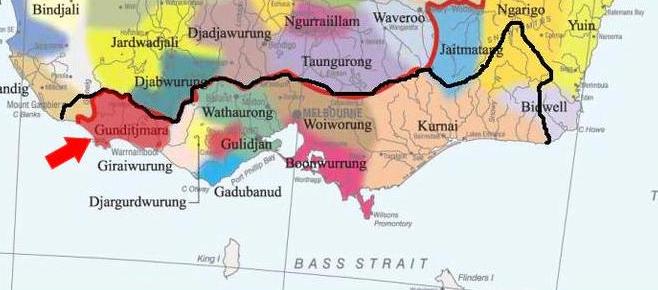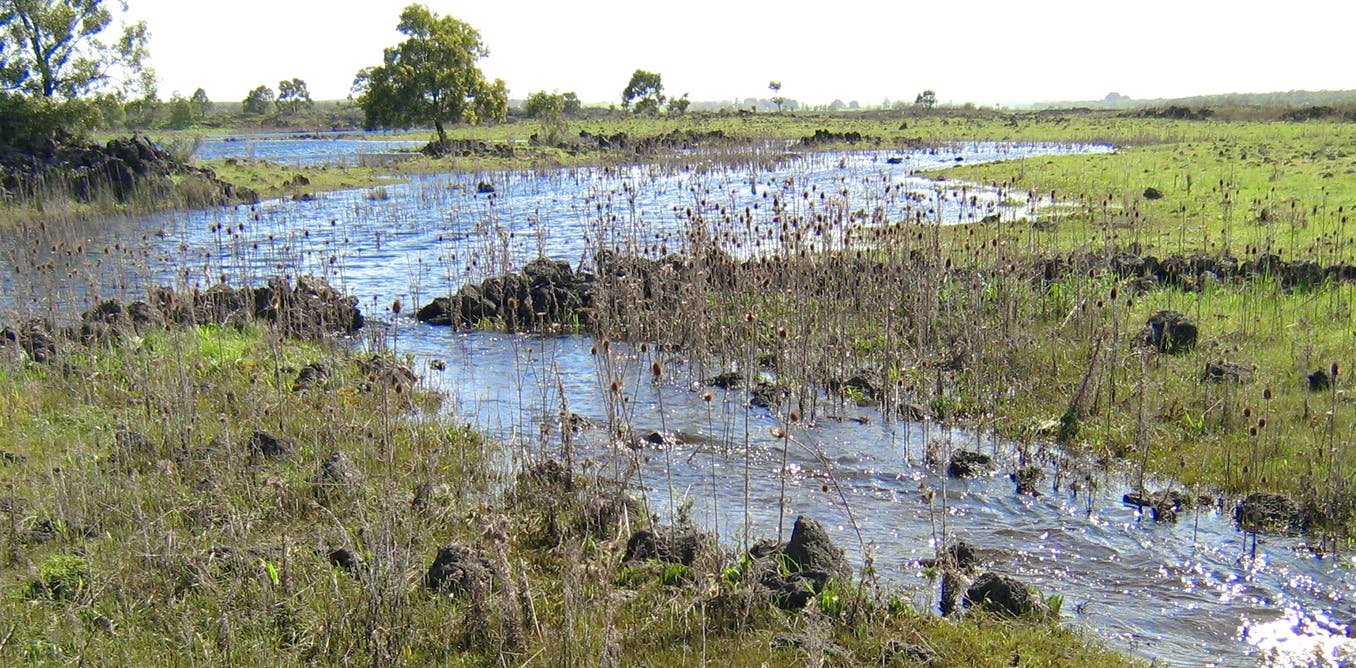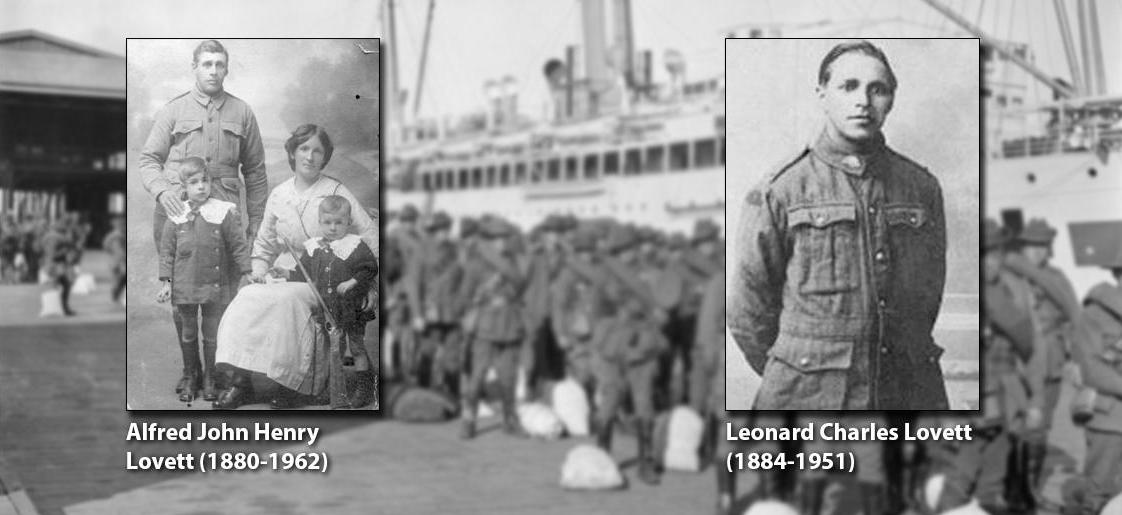Recognising the Lovetts and their contributions to the Australian military.
The Lovett family belong to the ‘fighting Gunditjmara.’ Gunditjmara people from South West Victoria earned this title in the 1800s because of their strong resistance to invasion of their Country. The Lovett family have continued this legacy through military service. Overall, 21 Lovett men and women have served Australia abroad in countries including Japan, Vietnam, Korea and Afghanistan, and all have returned home safely. The family's military record is believed to be unequalled in Australia.

Five Lovett brothers left Lake Condah Mission to fight in World War I (1914-1918). These were Alfred, Leonard, Frederick, Edward and Herbert and they were the children of Hannah (née McDonald), a member of the Kerrup-Jmara clan of the Gunditjmara nation and James Lovett, an Aboriginal man from South Australia.
Incredibly, all five brothers returned home safely. Four of the brothers later went on to serve in the World War II (1939-1945) as well. Their family story is a strong reflection of the contribution that thousands of Aboriginal men and women have made to Australia’s military history, at a time when human and citizenship rights were denied to Aboriginal people at home.
In recognition of their contributions, the building that contains the Department of Veteran's Affairs in Canberra was named Lovett Tower. The stories of the Lovett family contain pain and suffering but also highlight the courage, bravery and resistance of Aboriginal people.
How did WW1 change life for Indigenous Australian soldiers?


The lakes and rivers on Gunditjmara Country are of great spiritual and economic importance for Gunditjmara people, and they and their ancestors have cared for Country for thousands of generations.
*The Lovett Brothers Profile Source: First Peoples State Relations - The Lovett brothers
Alfred John Henry Lovett (1880-1962)
Private Alfred Lovett enlisted on 29 July 1915, just before his 36th birthday. After training in the Middle East from October 1915 to March 1916, he fought with the 26th Battalion. He later transferred to the 12th Battalion.
Alfred participated in the battle of the Somme in France, including battles for Poziéres and Mouquet Farm. He returned to Australia in March 1918 and was discharged in June that same year. He was awarded three service medals.
As a civilian, Alfred worked as a horse breaker and trainer near Casterton. He was also a well-known jockey. He married Sarah Spring, from Hamilton, with whom he had two sons. They ran a farm in the region.
Leonard Charles Lovett (1884-1951)
Leonard, commonly known as Charlie, enlisted on 27 May 1916 and served as a Private in the 39th Battalion of the 3rd Division. He fought on the Western Front, including significant campaigns at Passchendaele in 1917 and Amiens in 1918. He returned to Australia in 1919 and was awarded two service medals.
Many people were surprised to discover that Leonard spoke fluent German. It is thought that he picked up the language while working around Tarrington, near Hamilton, which was settled by German-speaking pioneers.
Among his occupations, Leonard worked as a drover. He married Elsie Maude Clark, with whom he had seven children. Leonard re-enlisted during WWII. Between 1941–42, he was stationed in Australia as a Private with the 3rd Garrison Battalion. His daughter, Alice, served with the Women's Auxiliary Australian Air Force in WWII and his son, also named Leonard Charles, served in the Korean War. His grandson, Mervyn, served in the Vietnam War.


Frederick Amos Lovett (1887-1958)
Frederick enlisted on 13 May 1917. He was a Private in the 29th Reinforcements of the 4th Light Horse Regiment and fought in Palestine. He was discharged on 15 June 1919 and awarded two service medals.
He married Mary Murray Rose and had 11 children. His daughter, Laura Bell, is also a 2013 inductee to the Victorian Indigenous Honour Roll. Frederick worked as a labourer for many years.
Frederick re-enlisted in March 1942. He was a Corporal and served in the Australian Army Catering Corps as a cook. He was discharged from the army in July 1947 at the age of 60. Frederick's grandson, Sergeant Ricky Morris, has recently served in the army with the International Force for East Timor and in Afghanistan.
Edward McDonald Lovett (1893-1957)
Edward was known as 'Mac' and enlisted on 17 August 1915. He was a Trooper with the 4th Light Horse Regiment and the 13th Light Horse Regiment that patrolled the Western Front. He returned to Australia in May 1919 and was awarded two service medals.
A single labourer when he joined, Edward married Rose Ann Heron before he shipped out in 1915. The couple had two children, a son and daughter. They ran a billiards hall and pub in Hamilton for a time. Edward also worked as a labourer.
Edward re-enlisted in 1940 and served as a Corporal at the number 12 Garrison Battalion until 1943. Edward's daughter, Sarah Pearl, also served in the Australian Women's Army Service during WWII.
Herbert Stahle Lovett (1898-1976)
Herbert, the youngest of the brothers to serve in WWI, enlisted in 1917. As he was only 19 years old, his parents were required to give special permission for him to join. He fought on the Western Front as a Private in the 15th Machine Gun Company and participated in the attack that broke the Hindenburg Line in 1918, the last and strongest of the German army's defence. He was discharged in July 1919 and was awarded two medals for his service.
Herbert married Emma Foster from Harrow in 1926 and went on to have six children. His daughter, Iris Lovett Gardiner, was inducted to the Victorian Indigenous Honour Roll in 2012. Herbert was musically gifted and played the organ at Lake Condah's church. He was also the choirmaster and worked in the timber industry.
In August 1940, Herbert re-enlisted as a Private. He served as a cook in the Australian Army Canteen Corps and was discharged in October 1945.

.jpg)
Injustices Faced
The circumstances in which the Lovett brothers and many other Aboriginal people signed up to fight for Australia were extremely complicated and challenging. Aboriginal people were continuing to face theft of land and Country, discrimination, racism and violence. For many, joining the military provided an opportunity to be seen, paid and treated as equals. However, after the First and Second World War, Aboriginal service people returned to the same situation of colonisation and discrimination and were not respected as veterans.
For example, the Soldier Settlement Scheme aimed to provide returning soldiers with work and land. This involved subdividing large rural estates into smaller farming blocks and leasing them back to returned service-people. However Aboriginal soldiers were denied access to this scheme. This included the Lovett family, as Lake Condah Mission where they previously lived was divided under this scheme and land was granted to non-Aboriginal soldiers.
Regardless of injustices that the Lovett family faced, there's no denying the courage and service they've provided for their country and people.
To learn more about their story and their continuing battle for justice, please watch the video below and refer to the 'Sources/Further Reading' links.
Sources/Further Reading
- Aboriginal Victoria - The Lovett Brothers
- Herald Sun - Five brave Lovett brothers among the WWI diggers to be commemorated for centenary celebrations
- The Age - Lovett family war effort comes of age
- ABC News - Aboriginal brothers recognised for unprecedented military service
- ABC News - Fight for compensation over land Aboriginal war veteran Herbert Lovett was refused
- The Standard - Fighting for a shot at a better life, a trait of the Lovett family
- Gunditjmara Aboriginal Cooperative Ltd
- Aboriginal soldiers: rewarded with racism and discrimination
- The Conversation - The detective work behind the Budj Bim eel traps World Heritage bid (Lake Condah Image Source)
